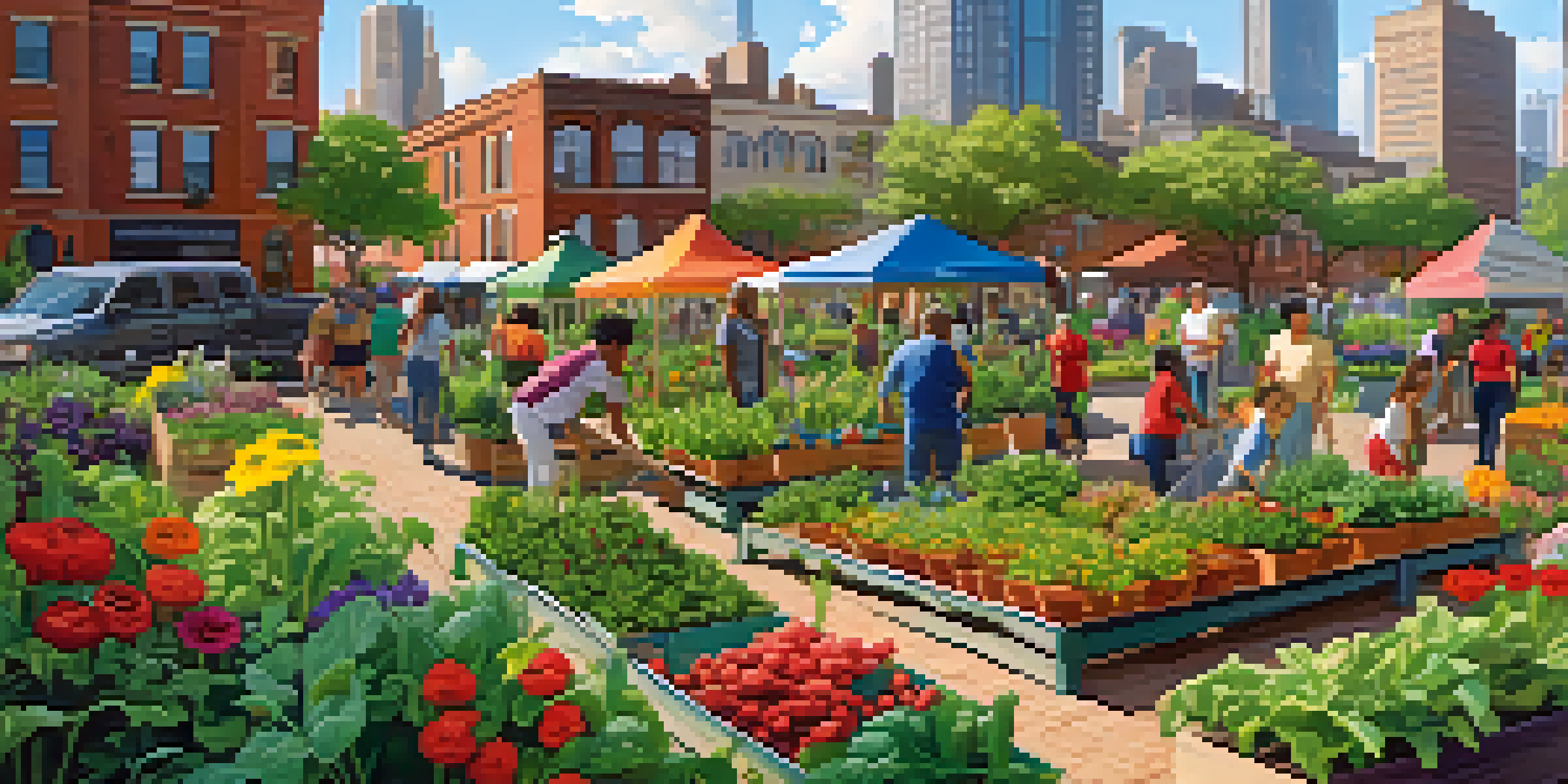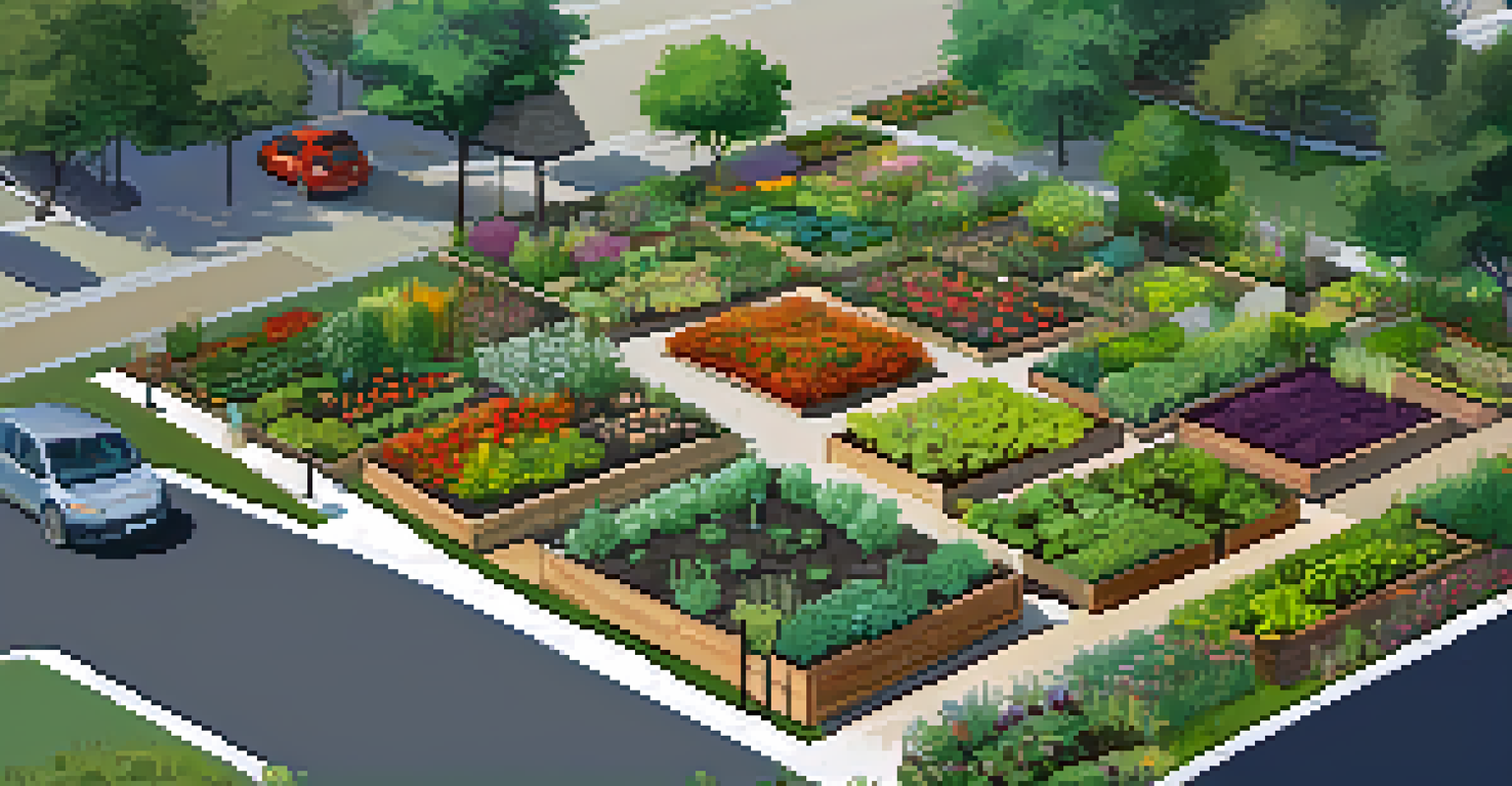The Role of Community Gardens in Sustainable Urban Design

What Are Community Gardens and Their Purpose?
Community gardens are shared spaces where individuals come together to grow fruits, vegetables, and flowers. They serve as green oases in urban landscapes, fostering a sense of community and collaboration among residents. These gardens are often managed collectively, allowing people from diverse backgrounds to contribute and benefit from the harvest.
The greatness of a community is most accurately measured by the compassionate actions of its members.
The primary purpose of community gardens is not just to produce food, but to create a vibrant community space. They encourage social interaction and help build relationships among neighbors, which can be particularly important in densely populated areas. In essence, these gardens transform underutilized land into productive and engaging environments.
Moreover, community gardens play a crucial role in promoting environmental sustainability. By growing food locally, they reduce the carbon footprint associated with transporting produce from farms to urban centers. This connection to nature not only enhances local biodiversity but also inspires a deeper appreciation for the environment.
Environmental Benefits of Community Gardens
One of the most significant environmental benefits of community gardens is their ability to combat urban heat islands. These gardens introduce greenery into concrete-heavy areas, helping to cool down the surrounding environment. This cooling effect can lead to reduced energy consumption for air conditioning, which is a win-win for both the planet and residents' wallets.

Additionally, community gardens support biodiversity by providing habitats for various species, such as pollinators like bees and butterflies. This is vital for maintaining healthy ecosystems, especially in urban settings where natural habitats are often compromised. By fostering such biodiversity, urban gardens contribute to ecological resilience.
Community Gardens Foster Connection
These shared spaces promote social interaction and community building among diverse residents.
Lastly, these gardens promote sustainable waste management practices. Many community gardens encourage composting, turning organic waste into nutrient-rich soil. This not only reduces the amount of waste sent to landfills but also enhances soil health, creating a cycle of sustainability that benefits both the garden and the wider community.
Social Cohesion Through Community Gardens
Community gardens are powerful tools for building social cohesion in urban neighborhoods. They create a shared space where individuals can gather, share stories, and learn from one another. This sense of belonging is particularly valuable in cities where social isolation can be prevalent.
Community gardens are a way to bring people together, to grow food, and to create a sense of belonging.
Furthermore, these gardens often host workshops and events, such as cooking demonstrations or seasonal festivals. Such activities not only educate participants about gardening and healthy eating but also foster a sense of pride and ownership in the community. When people invest their time and energy into a garden, they’re more likely to care about their surroundings.
By bringing people together, community gardens can break down barriers related to age, ethnicity, and socioeconomic status. They create a level playing field where everyone can contribute equally, fostering inclusivity and understanding. This shared experience is essential for nurturing strong relationships and a supportive community.
Economic Benefits of Community Gardens
Community gardens can also have a positive economic impact on urban areas. By providing access to fresh produce, they help reduce food insecurity, especially in neighborhoods classified as food deserts. This means that residents can enjoy healthier food options without having to travel far.
Additionally, these gardens can increase property values in their vicinity. Beautiful green spaces are often seen as desirable amenities, attracting potential homebuyers and renters alike. The presence of community gardens can enhance the overall appeal of a neighborhood, contributing to economic growth.
Environmental Impact of Gardens
Community gardens enhance urban biodiversity and help mitigate the effects of climate change.
Moreover, community gardens can serve as platforms for local entrepreneurs. They often encourage the development of small businesses, such as farmers' markets or local food co-ops, which can stimulate the local economy. This entrepreneurial spirit can create jobs and foster a sense of community ownership.
Educational Opportunities Provided by Community Gardens
Community gardens are excellent educational resources for people of all ages. They provide hands-on learning experiences about agriculture, sustainability, and nutrition. Schools often partner with local gardens to teach students about where their food comes from, fostering a greater appreciation for healthy eating.
Workshops and volunteer programs in community gardens can teach valuable skills, such as organic gardening techniques and composting. These educational experiences empower individuals to take charge of their food systems and make informed choices. Understanding sustainable practices can inspire participants to implement similar strategies in their own homes.
Additionally, community gardens often engage with local organizations to offer programs focused on environmental stewardship. These initiatives can range from tree planting to water conservation efforts, instilling a sense of responsibility towards the environment in participants. Education in community gardens not only benefits individuals but also cultivates a more environmentally conscious community.
Challenges Faced by Community Gardens
Despite their many benefits, community gardens often face challenges that can hinder their success. One major issue is securing land access; urban areas are increasingly competitive, and finding suitable plots for gardening can be difficult. Without a stable location, gardens risk being displaced or shut down.
Moreover, maintenance and funding can pose significant hurdles. Many community gardens rely on volunteers for upkeep, which can be inconsistent. Additionally, securing funding for tools, seeds, and other resources can be a challenge, particularly in economically disadvantaged neighborhoods.
Economic Benefits for Neighborhoods
They provide access to fresh produce and can stimulate local economies through small businesses.
Lastly, community gardens must navigate the complexities of local zoning laws and regulations. These legal requirements can vary significantly from one area to another, creating confusion and potential roadblocks for garden initiatives. Overcoming these challenges requires persistent advocacy and community engagement.
The Future of Community Gardens in Urban Planning
As cities continue to grow, the role of community gardens in urban planning becomes increasingly important. Urban planners are recognizing the need for green spaces to enhance the quality of life for residents. Integrating community gardens into city designs can create healthier, more sustainable environments for everyone.
Future urban planning initiatives may include policies that prioritize green spaces, such as allocating land specifically for community gardens. This proactive approach could ensure that gardens are not only preserved but also expanded in urban areas. Increased collaboration between city officials and community members will be essential for this vision to become a reality.

Furthermore, as awareness of climate change and food insecurity grows, community gardens can be a vital part of solutions. By incorporating these spaces into urban designs, cities can foster resilience against environmental challenges while enhancing community well-being. The future looks promising for community gardens as they continue to play a crucial role in sustainable urban development.